Journey to the Edge: Peer-to-Peer Computing and Content Control
Peer-to-peer computing, or P2P as it is often abbreviated, had a poster child whose impish grin that annoyed the music industry. Napster may be no more.
The legacy of Napster, however, remains.
Grassroots MP3 ripping and distributed indexing have traction. A person with information to share-please, visualize an 18-year-old male at a snow-clogged university in Fargo, North Dakota-converts a music track on an audio CD to an MP3 file. [FOOTNOTE 4 The process of converting a CD audio file to the MP3 format is called ripping. There was a moment of levity at the Consumer Electronics Show in late 2000 when the president of Intel was firmly corrected by a female engineer who said, "No, Mr. Barrett. It is called ripping a song." ]
The tool of choice is Aimster. The name Aimster was cobbled from America Online Instant Messenger and Napster. The software developed by John Deep (Troy, New York) allows AIM users to allow other AIM users to locate and copy files on one another's computers. Unlike Napster, AIM users are on one another's buddy lists. The index of files is on each AIM user's personal computer. When one AIM user wants to copy a file from a "buddy's" computer, the transfer takes place between the two machines. Aimster has a search function that prowls the directory of the buddies' computers. When the desired file is located, the transfer takes place. The speed of the transfer depends on the bandwidth available to the machines. Otherwise, the request and transfer are almost instantaneous. Aimster uses ICQ, a popular messaging client and AOL's Instant Messenger to detect buddies. In order to prevent an Aimster-type of search-and-retrieve function, changes are needed to the architecture of these programs or Aimster users would have to be denied access to these popular services.
Aimster eliminates the centralized index running on Napster's servers. The Aimster service is a true peer-to-peer technology. Napster, like Ray Ozzie's Groove, has a server coordinating certain functions among the peers.
Aimster may be shut down by the time you read this because peer-to-peer architectures pose three formidable challenges to users, copyright holders, and organizations.
First, P2P systems are often persistent. As a result, bandwidth and connectivity requirements are different from such common applications as checking e-mail or browsing a handful of Web sites. The data transfer associated with Napster, for example, eroded the performance of some university computing systems. Institutions such as Indiana University (Bloomington, Indiana) prevented university computing users from using Napster in order to restore system performance.
Second, security in P2P systems is a work in progress. Intel Corporation has developed and released to members of its developer community a P2P security toolkit. But the reality of P2P computing is that resources available to members of the community are subject to the security on each individual machine connected by the P2P system.
Third, P2P systems are finding their way into the next-generation computing architectures from Microsoft Corporation and Sun Microsystems. Microsoft's Dot Net initiative allows programmers access to a powerful suite of tools that allows enterprise-class applications to be built using C#, SOAP, and XML. Similarly, Sun Microsystems's JXTA (Juxtaposition) allows P2P applications to be built using Java, technology from Infrasearch (gonesilent.com), and Solaris's built in functions. A good example of what is going to be the next-generation of information management tools may be seen by visiting David Gerlanter's recent innovation at www.mirrorworld.com. Using Java, Mirror Worlds' software creates a dynamic, aware "computing space." Content added to a machine in the "space" is indexed and made available to the other machines on the network. A user can perform a search, or a standing profile can alert the user that information of interest to him / her has become available.
Managing these three issues promises to be a challenge for the most seasoned information technology manager.
The marketing role of Napster has been significant. Napster was a viral success. In a matter of months, an estimated 60 million people were given a crash course in the benefits of P2P computing. The demographics of the Napster user hit the sweet spot of wired youth between the ages of 13 and 25. Little wonder that P2P applications are flowing into the market at a lightning clip. Microsoft and Sun are playing a bet-the-farm game with Dot Net and JXTA. P2P is very real, and it is going to be what management consultants call a "structural discontinuity" in the present online information storage, search, and retrieval world.
Napster showed millions worldwide how to share their favorites without fooling around with trips Tower Records, trading cash for tunes. In retrospect, for those over 55, the furor over Dr. Dre's mellifluous "Nuthin' but a 'G' Thang" is amusing, even quaint. Copyright-sensitive information professionals were, shall we say, disquieted.
So Napster has spawned Son of Napster. Remember how in those 1950 Japanese B movies Mothra, Rodan, and Godzilla kept coming back. Each return brought a tougher, nastier beast.
The P2P torch has been passed to other entrepreneurs such as Mr. Deep and to industry superpowers such as Microsoft and Sun.
TICKET TO RIDE (THE BEATLES)
The furor over peer-to-peer computing is one of those peculiarities of technology. P2P has been around a long time if one views the Internet as an older model of today's streamlined P2P systems. Telnet can provide some rudimentary P2P functionality, but the command line is not as inviting as a graphical user interface, an agent-based spider, and a chunk of broadband for data transfer.P2P technologies are often called "edge of network services." The phrase "edge of the network" is can be somewhat misleading, but it is catchy. The peer-to- peer architectures move functions once reserved for a centralized server to clients located anywhere and everywhere. Servers--particularly in commercial- grade P2P applications such as Consilient's knowledge management and collaboration system-are used within the P2P architecture.
Edge, however, conveys an image of moving functions from a centralized clutch of servers that are chokepoints for some users' activities to a borderless and fuzzy anywhere and everywhere of Web services.
The basic idea for peer-to-peer services is that the server is a gateway for far too many actions that capable, powerful personal computers want to take. The server for some types of applications is little more than an excuse for a systems administrator to become a gatekeeper. Servers have to be watched and maintained by system administrators, whose administrative processes get in the way of what users want to do. Centralized servers give those who control them a considerable degree of power over what users can do and when.
Users of the original Napster taught millions of computer users the old- fashioned server set up is not for them. Some enlightened network users recognize that servers do perform some useful functions, but with the increasing power of the basic desktop machine, seemingly ever-increasing bandwidth for those who can afford it, plus a growing array of wireless computing devices- servers and clients were not the most efficient way to deliver one-to-one or one-to-a-community computing. Peer-to-peer architectures are well on their way to becoming the ticket to ride the Internet in an unencumbered, organic way.
Dot Net and JXTA will facilitate the development of many "flavors" of peer-to- peer computing. There is considerable disagreement about the details of how specific services can and should be provided in a particular implementation of a specific peer-to-peer architecture. To its credit, Microsoft has made the C# programming language (a combination of Visual Basic and C++) and the Simple Object Access Protocol (a mechanism for the exchange of messages and data across and among machines running different operating systems and programs) into technologies that are "open." Sun Microsystems, on the other hand, has kept proprietary control of Java. As a result, a battle of the giants is shaping up for 2002.
In the examples of P2P systems included in this essay, a handful of common functions are used within different P2P architectures. What might be thought of as the six building blocks of P2P services are:
What makes peer-to-peer applications interesting to many developers is that the network of machines can support agent-based and automated services. In fact, the significance of Dot Net is the architecture's awareness of events within a network environment. Practical applications of this technology translate to a single log on for a user's services, a way to roll up financial data in a real time view from within any Windows application, and seamless crossplatform access by a user to address books, files, and colleagues. If Dot Net and JXTA perform, a user will be able to begin work on a project at a computer connected to his employer's system, continue work on a wireless PDA, and then output the spreadsheet to the notebook connected to his / her home's wireless network.
Without a server acting as a traffic cop, intelligent scripts can ferret out information and perform a wide range of tasks. Software can watch for new information and take specific actions when a particular event occurs in a folder on a machine in a peer-to-peer network. For example, a lover of a great "artiste" such as Eminem will be alerted via e-mail when a new Eminem's album is released. The structure of a peer-to-peer network unfolds a rich landscape which can be mined, monitored, and explored in many ways. Individual peers on a network can largely control their own actions.
Each of the major architectures for peer-to-peer networks can been modified. The six building blocks can be mixed and matched to meet specific needs. In the next section of this essay we look briefly defines each major type of peer-to-peer architecture is needed. Once the definitions are behind us, we will wrap up by looking at several examples of each major type of peer-to-peer architecture.
Peer-to-peer architectures perform the same type of functions that most users are familiar with. The jump into the great beyond is that peer-to-peer services are distributed over multiple computers unbounded by the reach of the cabling in an office. The three types of peer-to-peer architectures are in use at this time:
The terminology is confusing enough to make differentiating them tricky. Very simplistic diagrams of each of the three types of architecture accompany brief descriptions of each of these main types.
The Many-to-Many Architecture
Napster and its variants are excellent examples of many-to-many computing, the architecture that gave sweet dreams to many music lovers. The architecture is sometimes described as the Gnutella model or public information sharing. Any number of computers can make files available to other users. The database containing information about what files are available to others resides on a database server. The next-generation peer-to-peer architectures exploit virtual directories and database servers. Because these exist only in memory, shutting next-generation servers may be more difficult. In a peer-to-peer network, a search engine allows any user to locate information on any machine included in the peer-to-peer system. When a match is found, the user is able to link to a specific machine and copy the required file or information. An important distinction between Napster and Gnutella is that Gnutella does not have a central directory exactly like Napster's.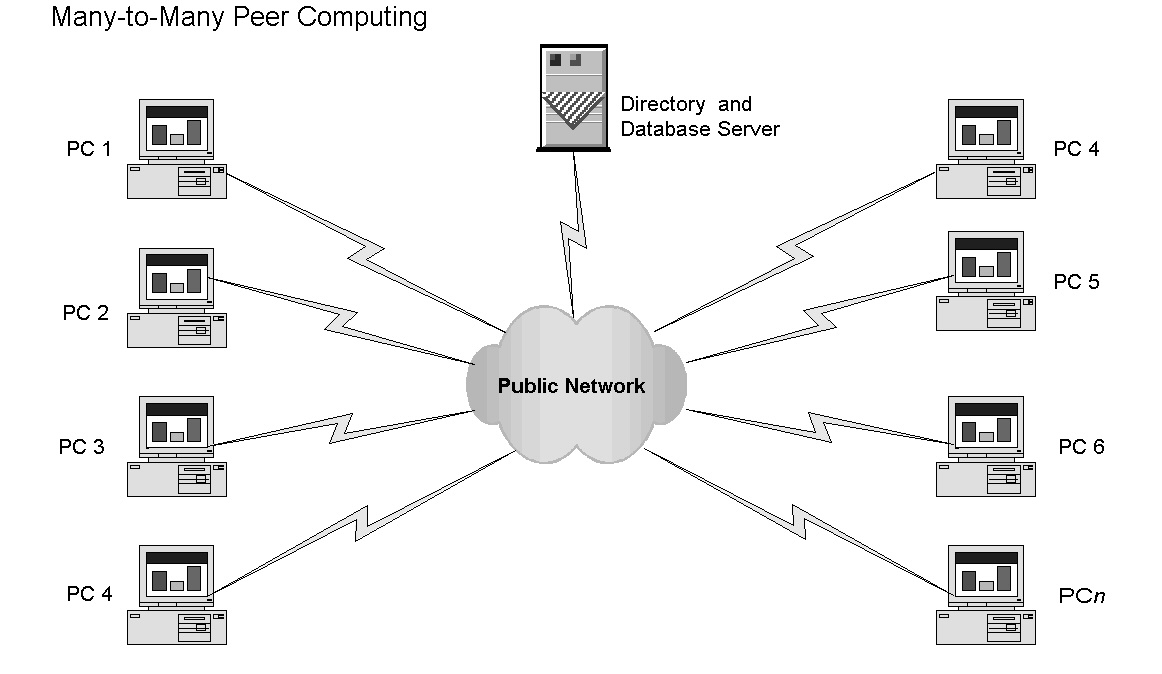
Few-to-Many Architecture
Few-to-many computing is cleverly implemented in the SETI@Home system. (SETI is an acronym for the Search for Extraterrestrial Intelligence.) A small number of master servers distribute tasks to computers connected to the Internet. The master servers collect the results of the tasks or problems distributed to the individual PCs available to the master servers. Many PCs work on specific tasks and make the results available to the master servers. This approach is also called distributed computing. Many computers work on problems that would require massive centralized computing resources to handle if the lower cost few-to-many model were not available.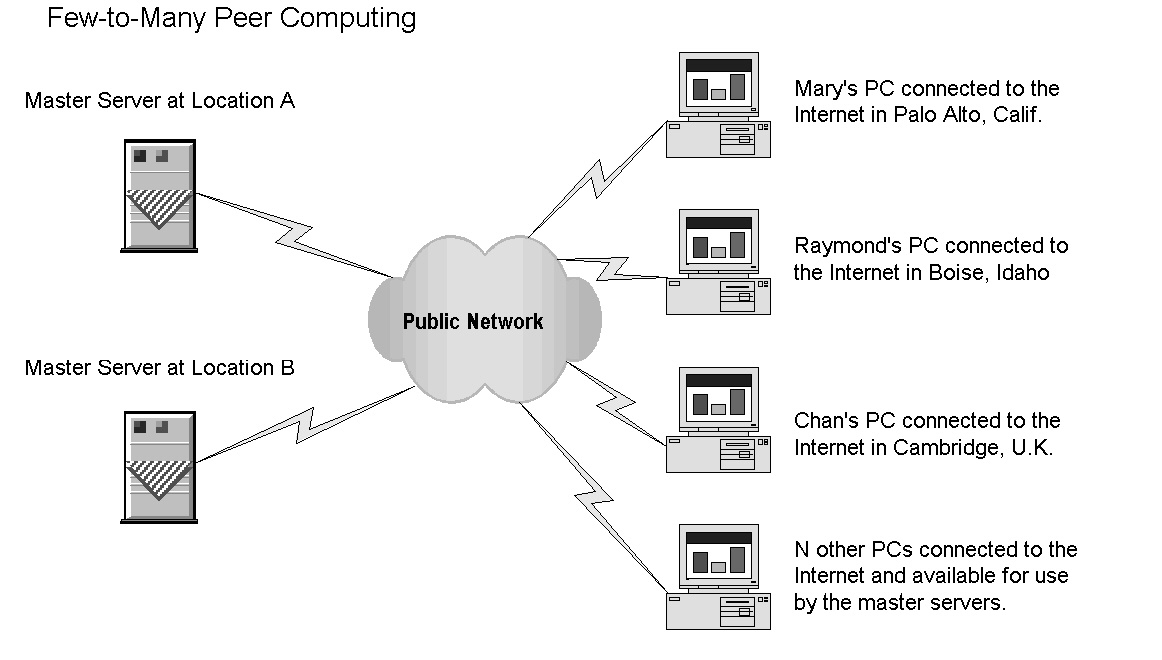
Few-to-Few Architecture
Few-to-few peer computing allows users to create a virtual "space" without having to involve a system administrator or invoke complex commands. Any user regardless of location and type of Internet connection can enter a secure virtual space and interact. Functions are controlled by the participants. Typical activities include shared Web browsing, text and rich media messaging, sharing files, etc. The eight users see and share as if each user were linked on a single network in a private virtual space.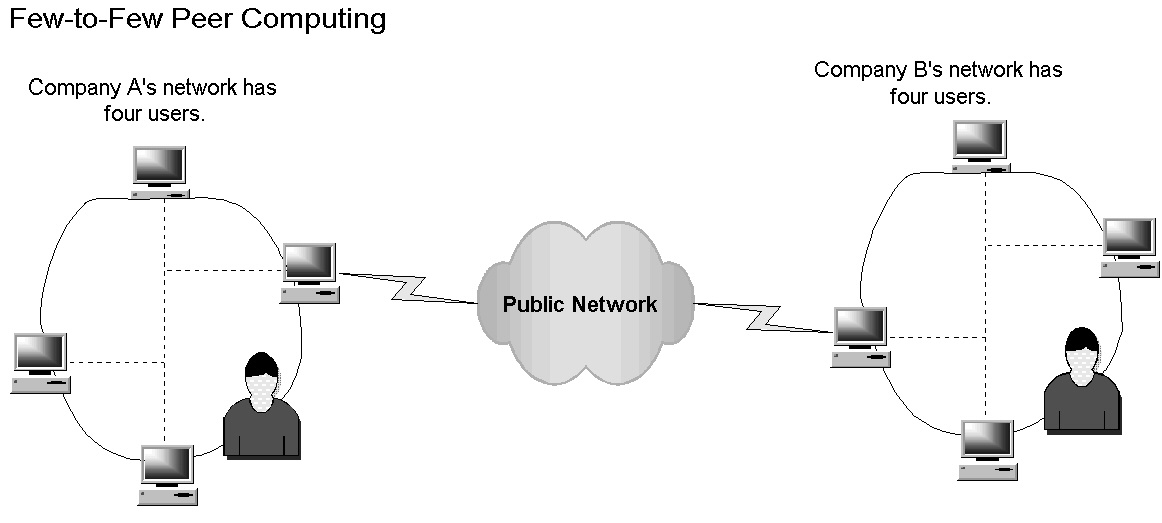
INTO THE GREAT WIDE OPEN (TOM PETTY & THE HEARTBREAKERS): GNUTELLA
Many-to-many computing is the digital equivalent of Spanish conquistadors standing on the shores of the New World-an earlier period's "great wide open." The opportunities were limitless, and the resistance mounted by the indigenous people was laughable.Peer-to-peer computing is personified in the media by one Gene Kan, whom we will encounter several times in the following pages. He has been one of the most visible drivers behind the Gnutella portal that is located at http://gnutella.wego.com. But the motive force of Gnutella was Justin Frankel, the programmer who created Winamp, one of the first, hugely popular "skinable" programs for listening to music via the Internet. Winamp gave the users unprecedented control over what to play and what type of interface best suited each user's personal tastes. The "skins" available for Winamp can make the Winamp interface look like a zebra- skinned settee or a control panel from the starship Enterprise.
Mr. Frankel sold his company to America Online (soon to be the owner of EMI and Warner recording properties), and while an employee of AOL, he and a handful of programmers polished Gnutella in their spare time while employees of AOL in early 2000. Without alerting AOL executives, Mr. Frankel released the program as open source code. Once released, anyone could download the code, make changes, and use the software to facilitate many-to-many online services.
Mr. Frankel seemed unconcerned about the machinations of corporate America in general and AOL in particular. He soon found himself the focal point of AOL corporate scrutiny. America Online yanked Mr. Frankel's Nullsoft Web page that provided access to the Gnutella source code. But...the action was a textbook case of locking the digital barn after the digital horse galloped into the great wide-open Internet.
Almost immediately, other programmers took Mr. Frankel's packet of code, disassembled it, rebuilt it, and in a matter of months made available the original code base plus six or seven important variants by the summer of 2000. Today one can see Gnutella as one of those programs that is playing a role similar to that of WordStar in word processing or Lotus 1-2-3. Although better programs came along, WordStar, Lotus 1-2-3, and Gnutella changed behavior.
Anyone wanting to use Gnutella must download software. For example, Gn00a can be used as it is. For the adventuresome and Big Music's squads of programmers, download Gn00b, a version that one can use to build a purpose-built Gnutella application. [FOOTNOTE 5 These programs are available at The Gnutella Developer home page, http://gnutelladev.wego.com/, managed by Gene Kan]
A Gnutella application plays a dual role. Once a user installs Gnutella, the personal computer is both a client responding to requests from others in the Gnutella "space" and a server providing services to other users also in the "space." (A "space" is the virtual meeting room in which a group of users gather.) The essence of Gnutella's many-to-many model is that a separate server is not needed for most functions. Peers provide the types of services normally assigned to a server in a traditional client-server network.
The Gnutella space is a virtual environment in which the peers can interact as if they were one system. Anyone with the Gnutella software running is a peer in this type of architecture. Security and access are not features implemented with the type of stringency one would find in a corporate network or in America Online's instant messenger environment. There are some similarities to the "party line" telephone connection. Anyone on the line could talk and exchange information.
After the software has been installed on a personal computer, the user connects to hosts that act as entrance points to Gnutella peers. The hosts usually provide only the IP address and port data and do not share files. One can locate Gnutella hosts by clicking to such portals as Gnutelliam and looking at the list of gateways now online. [FOOTNOTE 6 Gnutelliams is a useful Gnutella portal offering a directory of Gnutella client downloads for Windows, Linux/Unix, Java, and Macintosh It is at http://www.gnutelliams.com]
Because there is no central database containing look up tables for mapping users to data, Gnutella affords some user anonymity. The Gnutella software implements a procedure to tokenize and then hides the identity of the user generating a query.
When a connection is established, machines on the network communicate via messages. Each peer receives and sends messages. Gnutella supports a number of standard Internet and special purpose messages, including:
Get and push messages are requests for file transfer from the peer with the data to the peer wanting the data. When a peer with the requested data is behind a firewall, Gnutella allows that information to be pushed through the firewall to the requesting peer. This is necessary because firewalls are set up to prevent certain types of file transfers. For unlucky Gnutella users who find that both the peer requesting data and the peer providing data are behind firewalls, the file transfer is not possible.
In order to keep the Gnutella space from flooding available bandwidth with infinite rebroadcasts of messages, time out mechanisms are baked into Gnutella. Once sent, each message has a time-to-live function which decrements to zero. A zero TTL value causes the message to die.
At the same time as university programming classes were digging into Gnutella and many-to-many applications in class and in extracurricular hack sessions, the savvy Gene Kan emerged as the spokesperson for the Gnutella movement. In March 2001, he sold his InfraSearch technology to Sun Microsystems. (The splash page for the now discontinued service appears below.) Infrasearch will reemerge sometime in the coming months as a key component in JXTA, Sun Microsystems P2P system.
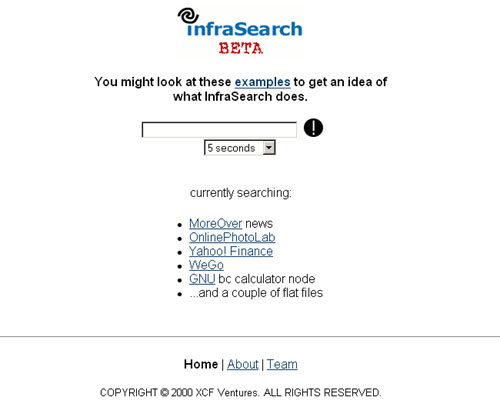
As president of XCF Ventures, Mr. Kan has been tapped by the media as the principal spokesperson for Gnutella. He has a high profile and presents the polished presence necessary to navigate in the treacherous straits between hostile legal forces and paranoiac multinational content companies. Gnutella variants are used by thousands of Internet users to locate and download pirated software, digitized motion pictures, pornography, and, of course, MP3 files. To get a feel for the traffic in Gnutella fueled services, query a newsgroup for the string "warez" and follow a handful of postings.
The many-to-many environment demonstrates asymmetrical sharing. Although there are thousands or millions of people on a system, the majority of the content is provided by a small percentage of users. According to Eytan Adar and Bernardo A. Huberman, "almost 70 percent of Gnutella users share no files, and nearly 50 percent of all responses are returned by the top one percent of sharing hosts. Furthermore, we found out that free riding is distributed evenly between domains, so that no one group contributes significantly more than others, and that peers that volunteer to share files are not necessarily those who have desirable ones." [FOOTNOTE 7 Eytan Adar and Bernardo A. Huberman, Free Riding on Gnutella http://www.firstmonday.dk/issues/issue5_10/adar/index.html, October 2000]
A glimpse at the future of Gnutella sparkles off the slick exterior of the most recent release of Bear Share, now in version 2.2.0. This is a Gnutella-based application from Free Peers, Inc. whose marketing collateral says, "Bear Share provides a simple, easy to use interface combined with a powerful connection and search engine that puts thousands of different files in easy reach." [FOOTNOTE 8 For the software click to http://www.bearshare.com. For gateway information, click to http://www.bearshare.net]
The most recent build provided the screen shot of the initial connection screen. Once a user locates a host, tabs provide point-and-click access to upload, search, and monitor functions.
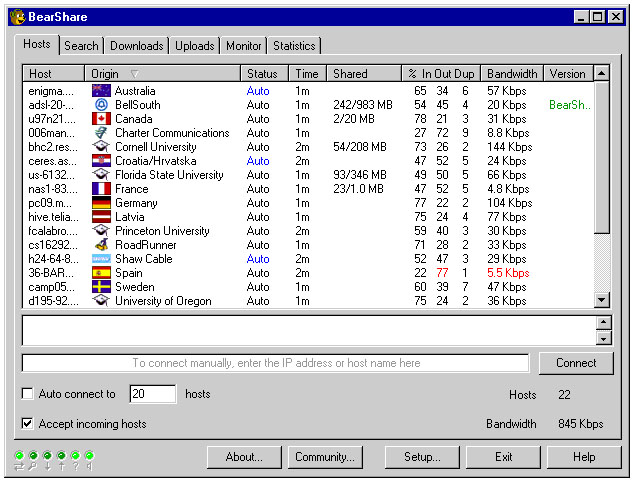
Among the features this release of the program are greater code stability, support for multiple active searches, active monitoring and updating of shared directories, and reverse lookup for computer addresses, among others.
The Florida-based company generates revenue from advertising and the operation of various hosting services.
Gnutella improved on the Napster model by eliminating to a large extent the centralized server that made Napster vulnerable to its critics. Many-to-many applications work when large numbers of people participate. The more data and people using the system increase the likelihood that the information one wants will be available from someone on the network. But success has a price.
The number of users on the system creates two problems. First, under load many-to-many systems are sluggish. With the increased number of users, visibility and buzz increases. The heightened visibility and the availability of information increases scrutiny of the content on the system. Copyright is the main point of contention in Gnutella-type systems.
Content company executives may want to ponder the words of Rob Lord, one of the programmers who developed Gnutella, "We didn't get into this 'space' cuz we're internet gold seeking cuckoos. We're legitimate nihilistic media terrorists as history will no doubt canonize us." [FOOTNOTE 9 http://www.nullsoft.com/, retrieved on March 14, 2001. From this site one may download BlorpScript, a GPL'd PHP image/content browsing system" and Aimazing, a nifty Winamp visualization plug- in.]
JUST CAN'T GET ENOUGH (NEW RADICALS): LOW COST SUPERCOMPUTING
At any one time, millions of computers are sitting idle and connected to the Internet. Why not harness the computational capabilities of these computers, creating one of the world's largest and least expensive supercomputers? This is the question that Berkeley computer scientists, among others, asked and answered. Distributed computing is the process of linking computers together over the Internet and putting their idle processing power to work to create a "virtual supercomputer." Many computer scientists cannot get enough computing horsepower to do their work. Using a peer-to-peer architecture offers one way to get access to calculating and storage resources.The most visible outcome of a scientist's need for inexhaustible computational horsepower is SETI or Search for Extraterrestrial Intelligence. [FOOTNOTE 10 More information is available from http://setiathome.ssl.berkeley.edu/]
The SETI Institute serves as an institutional home for scientific and educational projects relevant to the nature, distribution, and prevalence of life in the universe. The Institute conducts and encourages research and related activities in a large number of fields including, but not limited to, all science and technology aspects of astronomy and the planetary sciences, chemical evolution, the origin of life, biological evolution, and cultural evolution. The SETI@Home project is not directly sponsored by the SETI Institute. But the Institute has benefited from the publicity generated by the SETI@Home project.
SETI@Home project allows individuals to make their computer available for crunching the data returned from monitoring devices. A user downloads a software bundled that installs as a screen saver on the individual's computer. Participants include individuals, academic institutions, and various corporations, including Lehman Brothers, the French telephony company Alcatel, and the upscale consulting outfit Booz, Allen & Hamilton.
Once a personal computer is set up to participate in SETI@Home, servers at Berkeley copy a chunk of data collected with the Arecibo Radio Telescope, in Puerto Rico, as part of Project SERENDIP. The SETI Institute is a major supporter of the SERENDIP search.
The idea behind SETI@home is to take advantage of the unused processing cycles of personal computers. When the participants' computers are idle, the SETI@Home applet downloads a 300 kilobyte chunk of SERENDIP data for analysis.
The results of this analysis are automatically sent back to the SERENDIP team and combined with crunched data from SETI@Home participants in more than 200 countries. In the two years of SETI@Home operation, no sign of extraterrestrial life has been found. However, the distributed system has received has received about 300 million results from users around the world.
The limitations of this system are that only a 2.5 megahertz piece of the observed spectrum are analyzed by SETI@home. The data processing does not occur real time so that interesting signals are flagged and then analyzed further by project engineers.
The advantage of this scheme is that it permits looking for a variety of signal types that the current SERENDIP processing lacks processing capacity to analyze.
Other academics have tapped distributed computing to tackle other computationally-intense problems, including prime numbers, Fermat numbers, and optimal Golomb rulers. An organization called Distributed.net has focused on cryptography since 1997.
Among the commercial enterprises developing or offering products and services for few-to-many architectures are:
For enterprises looking for a low-cost way to build a distributed computing application TurboLinux sells EnFuzion for about $400. EnFuzion lets corporations farm out computing tasks across their computers using any operating system. Companies exploring distributed applications include J.P. Morgan, Procter & Gamble, and Motorola.
The applications for few-to-many computing are focused on computational or storage intensive tasks. This technology has some interesting commercial applications. The principal benefit from the technology is reducing the capital cost associated with adding specialized computers and storage systems. Costs for system upgrades cannot easily be driven to zero, but more efficient use of computing resources is one of the primary benefits of distributed architectures. The downside is that optimizing distributed system performance is still a challenging task. Schedulers and caching systems offer some performance improvements, but the field is comparatively new. Distributed computing has tremendous potential in engineering, scientific, and research applications.
CHEMICALS BETWEEN US (BUSH): GROOVE.NET
Few-to-few peer computing is a what might be called a "hybrid architecture." It blends one or more virtual servers that can perform security and performance functions with Gnutella-type peer-to-peer computing. The potential of distributed computing can be tapped if those participating require access to specific computational tasks or need specialized storage services greater than any single user's hard drive capacity. It allows the fluidity and openness of the many-to-many architectures but in a more controlled, tightly structured environment. The essence of this architecture is that a group of people working on a project can bond and interact in a secure virtual space.The principal problem with the many-to-many model is security-or lack of it. The hybrid architecture allows log in, authorization, usage tracking, and other services to be handled by a virtual server running necessary authorization services. Once a user is logged in, the few-to- few peer network looks and feels like a Gnutella session or an America Online chat room.
The leader of the few-to-few architecture is Ray Ozzie, the developer of Lotus Notes. After leaving IBM, Mr. Ozzie conceptualized a software environment that would exploit Internet services, yet provide the specialized functionality that enterprises and commercial organizations require.
Mr. Ozzie and his team worked for about three years to get Groove to the market. Groove is similar to a house decorated in Early American and Modern furniture. Handled with restraint and good taste, the mix is at once familiar and trendy. Groove has Notes-like functions, but it has the throttle touch of a Gnutella applet. [FOOTNOTE 18 Groove is located at http://www.groove.net and http://www.groovenetworks.com]
Groove is a system that brings together people, messages, discussions, documents, and applications in the context of a shared project or activity. Groove includes a range of collaborative tools, including a threaded discussion, chat, a notepad, a sketchpad, a calendar, and a file archive.
One can emulate to a degree Groove functions by cobbling together a suite of applications for a Notes and Domino environment. One can provide similar functionality by integrating Internet-accessible services from such companies as vJungle, building the missing bits from vJungle's OpenEx tools. Groove is one of the first companies to offer the hybrid service with security and control features baked in, not left out or glued on as an afterthought.
The Groove server is actually a bundle of code called the "Groove Relay." No single machine performs dedicated Relay functions. Instead, each peer executes Relay functions as required. Purists may argue that Mr. Ozzie has not created a hybrid peer-to-peer architecture. For those concerned with security, it is important to understand that the implementation of a virtual Relay server solves in part many of the security challenges associated with Gnutella for example. Groove can be configured to integrate with users' existing directory and certification systems.
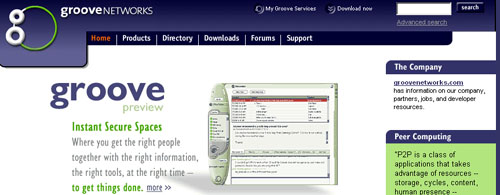
Groove users, even though invited to a shared space with security services running, could delete information from a shared space. They could invite other users to the shared space, so information you expected to be read by one set of eyes is now shared. They could even attach a file such as a ".exe" file with a virus using the Groove files tool. Alternatively, a user could attach a file containing a virus into the files tool. In this case, the virus would not fire until someone launched the attachment. In that case, the virus could affect the Groove user's personal computer.
Groove supports spontaneous collaboration. There is none of the complex set up required for audio conferencing needed. Groove accommodates users on local area networks behind different corporate firewalls, on dial up connections with dynamic IP addresses, behind cable-modems, and so on. Regardless of connection, a Groove user can create a shared space and invite other Groove users into it to work on a project.
When Groove members create information with the Groove tools, the data resides on the machines of all invited group members. The data are synchronized when a user or a group of users make changes. The biggest drawback to Groove is the quirky terminology the company uses. Instead of "voice chat," Groove prefers "transceiver." Groove's peculiar jargon impedes a new user's understanding of the services and features.
Invitations to join a "space" are issued using messages. A person who is invited to a Groove space must install the Groove application. Once the Groove applet is installed, the appropriate data are copied to the new user's machine. Each Groove member receives a complete copy of the shared-space data. The copying takes place in the background.
Because the shared space data for a particular Groove collaboration, a context for the messages and data are readily available to any user. This differs from the contextless snippets of electronic mail that often require one or more rounds of telephone tag to resolve and considerable inductive effort.
Anyone in a Groove shared space has the same information and data view as other members. The Groove shared space formed in this manner is secure. Each Groove space can be extended at any time to any person with whom members need to collaborate. No system administrator or coding is required.
The Groove relay brokers connections for devices behind firewalls and devices that talk with Network Address Translation conventions. Groove provides store-and-forward service so shared-space members can go offline, then reconnect and be resynchronized automatically.
Groove is a new type of product. Like any new network-centric tool, users must embrace it. At the time of this writing (March 2001), the Groove software is available for free. Groove may be a harbinger of how Internet operating systems will operate.
Alternatives to Groove will be coming with increasing frequency in the months ahead. The impact of Gene Kan and InfaSearch on Sun Microsystems will almost certainly lead to a product or toolset that supports Groove- type services. Java and the Solaris operating system are attractive conduits for secure, collaborative peer-to-peer applications.
Microsoft's Sharepoint Portal Server promises to deliver much of the same functionality for Windows 2000 environments. Coupled with Microsoft's "dot Net" initiative, the millions of programmers familiar with Microsoft languages will be able to snap together peer-to-peer applications by dragging and dropping widgets from a toolbar.
The impetus behind this new type of peer-to-peer service is the human need to communicate with the Internet packet as the digital morpheme. One can see mobile devices, notebook computers, and deskbound professionals entering virtual, secure spaces for a wide range of activities.
LIVING ON THE EDGE (AEROSMITH)
Peer-to-peer computing is an essential component of the pervasive
network. Each of the principal peer-to-peer architectures summarized in
this article can support a wide range of applications. What is the
impact of peer-to-peer computing on information companies producing
electronic content?
First, many information companies will make extensive use of peer-to-
peer technology in their own organizations. The collaborative power of
the few-to-few architecture and the potential cost savings of the few-
to-many architecture are easy to explain in terms of costs and benefits.
As pervasive computing becomes easier and always-on connections become a
reality in major cities, peer-to-peer functions slipstream easily into
many workflows. For example, a discussion about a marketing campaign or
a new product development project can exercise peer-to-peer systems in a
comfortable, intuitive way. It makes sense to share information among
team members. It makes sense to perform complex computing and storage
tasks using all the available resources.
Second, peer-to-peer computing is going to accelerate the development of
new types of information products and services. It is not clear if the
drivers of innovation will be the established firms or upstarts such as
Napster. Digitized video, digitized motion pictures, and digitized
anything lend themselves to systems similar to those of Napster and
Gnutella. This fact has not been lost on legions of programmers under
the age of 13 who see no good reason not to make it possible to share
games, images, books, videos, and music. Portals, print magazines,
books, and entirely new types of search-and-retrieval mechanisms are
already flowing into the market space blasted into Internet users'
consciousness with Napster.
Third, commercial enterprises have two short term tasks.
Job One for commercial information operations will be to understand,
monitor, and figure out how to deal with what promises to be an
continuing flow of software that can sidestep digital rights and for-fee
distribution systems. The task will be neither easy nor rewarding. Large
publishing companies are poorly equipped to deal with the technical
innovations of a high school student in Boise, Idaho, or a college
student in Osaka, Japan.
Job Two is to recognize that peer-to-peer technology offers new ways to
integrate content into professionals and consumers everyday activities.
My term for this new publishing model is "in phase distribution." The
idea is that peer-to-peer technology, combined with pervasive network
connections, allows an individual to access facts, numeric data, and
information at the precise moment the data are required.
"In phase" information implies a much closer blend of predictive
statistics, software agents, and event triggers. A doctor making her
rounds wants to have access to colleagues knowledgeable about a
particular patient. At the precise moment information is needed about
drug interaction, the physician will be able to shift from data
collection, to collaboration, to retrieving on point information about
what medication change to make. Similar opportunities will exist in
sales, legal, technical, and financial arenas.
In-phase communications means that the delivery of access when it is
needed and in the format required by a specific work or leisure context
points to new revenue opportunities.
Napster demonstrated that peer-to-peer technology can galvanize an
industry largely unchanged by the advent of the Internet. After the
recording industry, peer-to-peer technology will make its impact felt
upon motion pictures, professional publishing, anywhere content and
needs can be matched in real time.
The edge of the network is fast becoming the center of content delivery
innovation. For many information innovators under the age of 25,
Journey's song "Don't Stop Believing" is the perfect background to
inventing a new information distribution system.
Stephen E. Arnold
President, Arnold Information Technology
Postal Box 320
Harrod's Creek, Kentucky 40027
Electronic Mail: sa@arnoldit.com
Mr. Arnold is an information consultant. This article is derived from a
chapter in his most recent book The New Trajectory of the Internet,
published in May 2001 by Infonortics, Ltd. He resides with 13 servers
and two boxers in rural Kentucky.
[ Top ] [ AIT Home ] [ Site Map ]